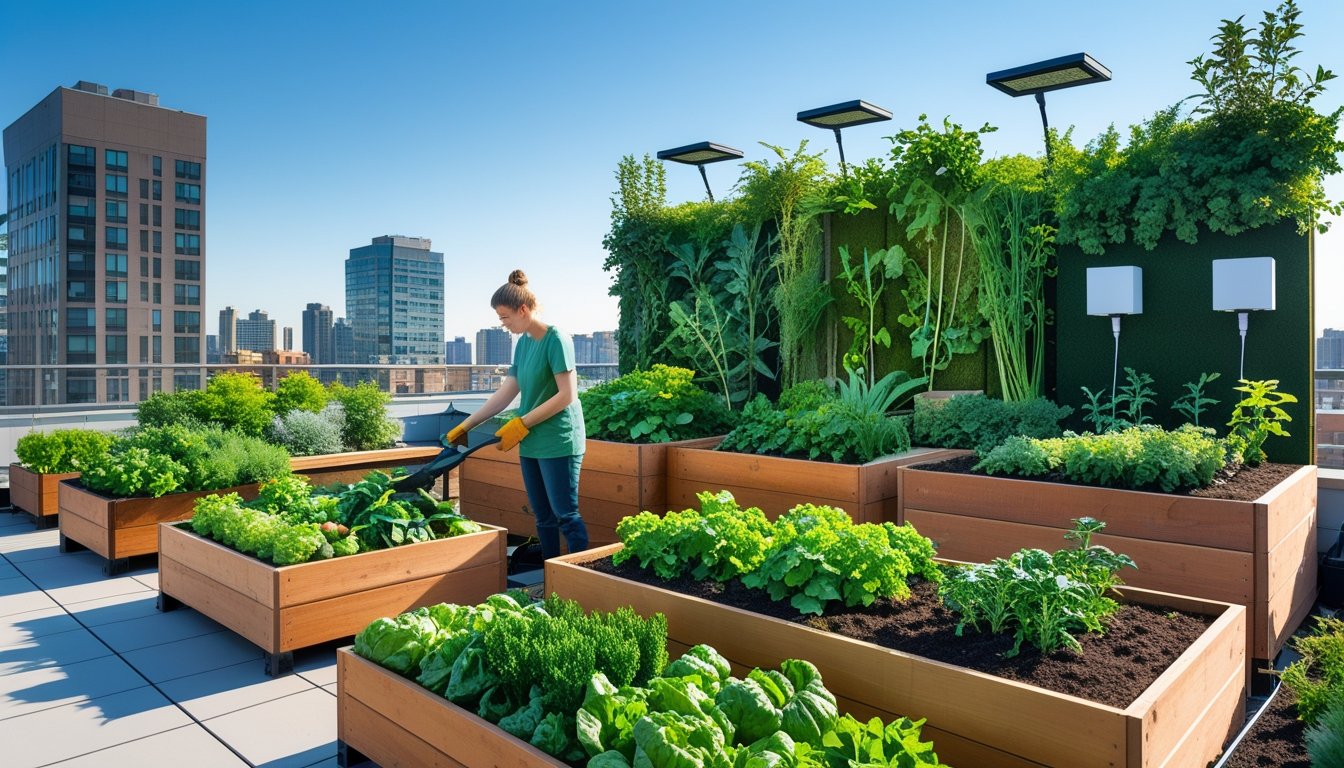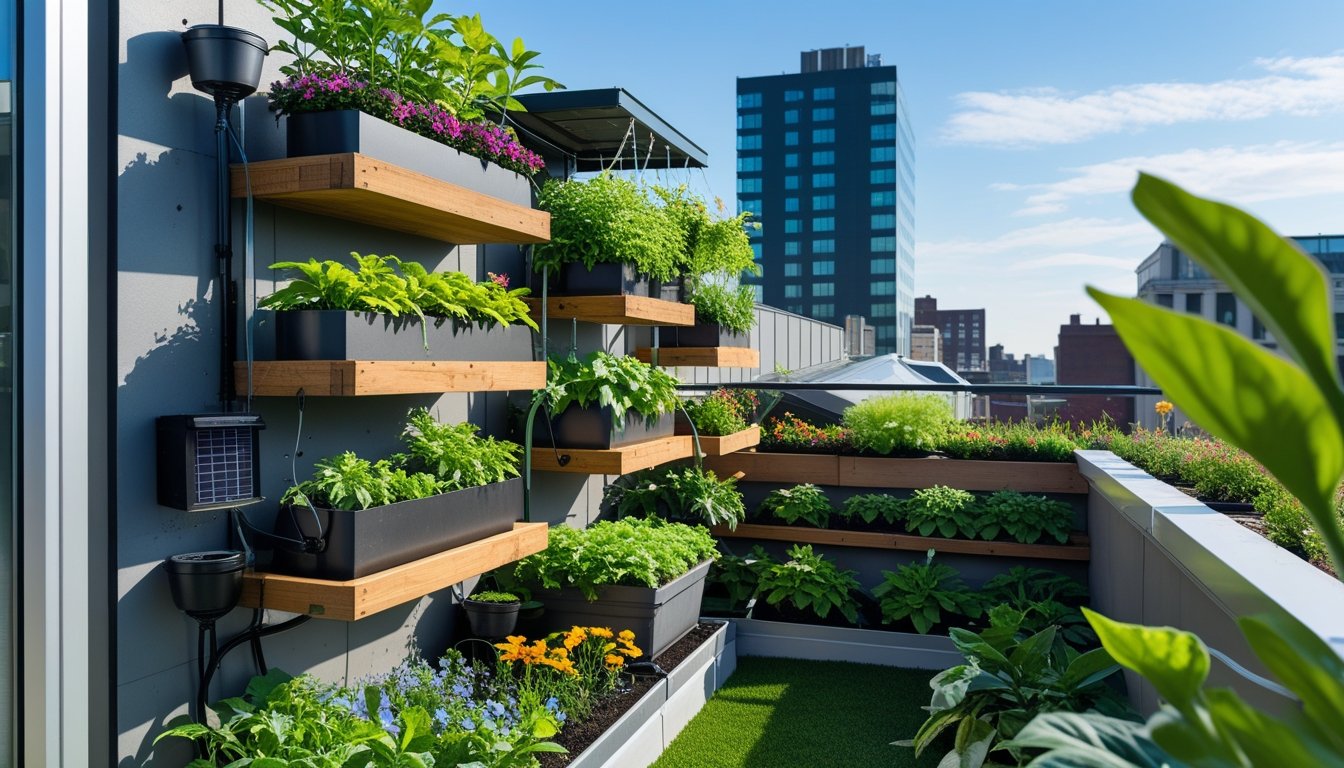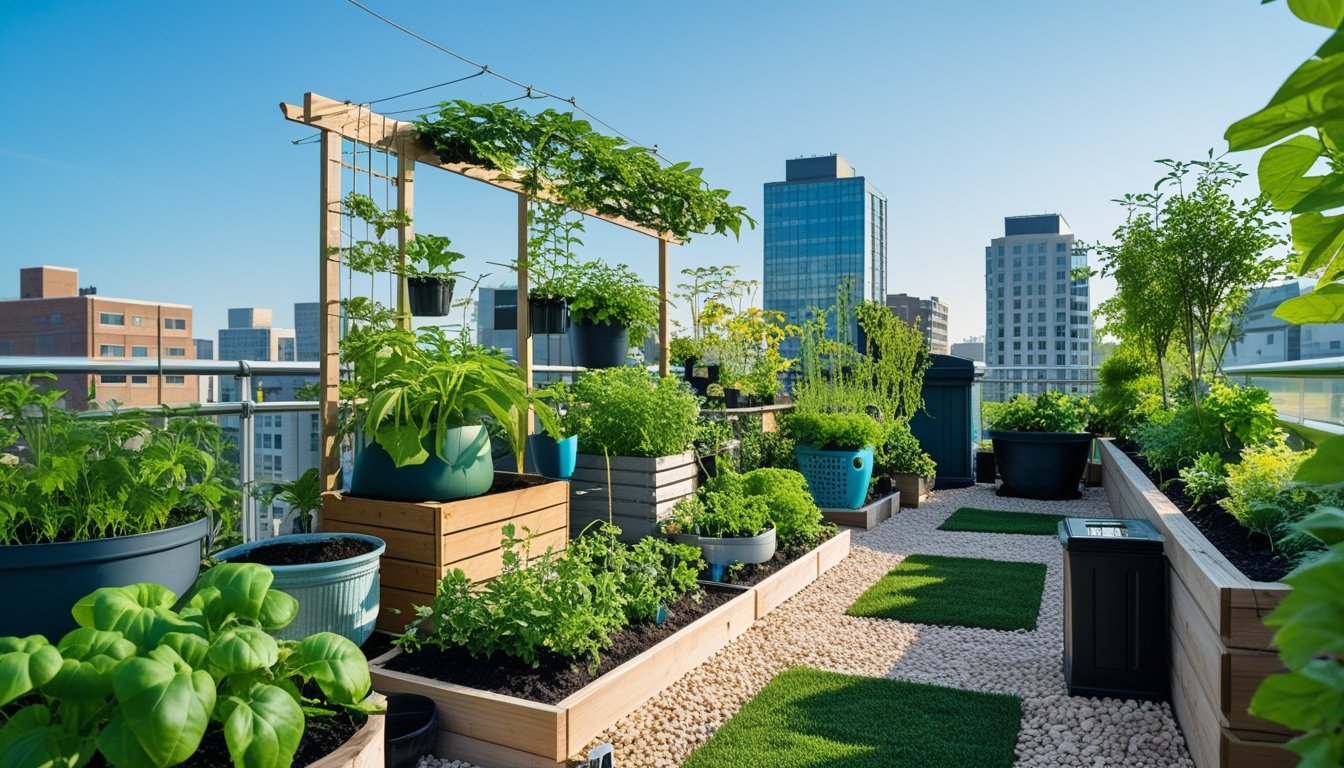Late updated: 09 Sep 2025 10:09
Written by: James Whitaker
Sustainable Garden Design Tips For Urban Spaces: Creating Green Havens In Cities
Transforming urban spaces into vibrant, eco-friendly gardens offers city dwellers a chance to reconnect with nature, even when outdoor space is scarce. Our cities are dense, but there’s an abundance of innovative solutions to create sustainable urban gardens, from utilising vertical and rooftop gardens to incorporating native plants that thrive with little maintenance. These gardens not only enhance the aesthetic appeal of urban areas but also contribute to biodiversity and improved air quality.

Sustainable garden design in urban settings requires creativity and resourcefulness to make the most of every square inch available. By applying permaculture principles, we can develop spaces that are both environmentally friendly and sustainable, involving techniques like composting and rainwater harvesting. This approach allows for a reduction in waste and a significant improvement in soil health, which is crucial for urban environments often lacking in natural resources.
Urban gardening provides opportunities to foster community connections and create green havens in the midst of concrete jungles. Through shared spaces and communal gardening projects, we can build a sense of belonging and cooperation among residents. These collective efforts not only beautify our surroundings but also have significant social benefits, promoting environmental awareness and enhancing communal well-being.
Key Takeaways
- Urban gardens maximise space creatively and sustainably.
- Effective design includes permaculture and resource conservation.
- Community involvement enhances social and environmental benefits.
Sustainable Urban Garden Design Essentials
Creating a sustainable urban garden in small spaces requires careful planning and resourceful strategies. From choosing the right plants to ensuring efficient use of water, each element plays a crucial role in transforming urban areas into sustainable green havens.
Maximising Small Urban Spaces
Urban gardening often involves working with limited areas such as balconies, rooftops, or small yards. Vertical gardening techniques and container gardening can maximise these constrained spaces. Vertical gardens not only save floor space but also create visually appealing green walls. Containers come in various sizes and can be artfully arranged. We should use tiered plant stands or hang planters to utilise vertical space efficiently. Also, reflecting surfaces like mirrors can enhance the perception of space and light.
Selecting Native and Low-Maintenance Plants
Choosing native plants is essential as they are adapted to the local climate and soil, thereby reducing the need for additional resources. Native plants often require less water, fertiliser, and care compared to non-native varieties. We should focus on perennials that return year after year without replanting. These plants not only conserve resources but also support the local ecosystem. Selecting varieties that thrive with minimal intervention helps in maintaining a sustainable urban garden.
Incorporating Biodiversity and Pollinator Support
Incorporating biodiversity in garden design encourages a healthy ecosystem. By planting a variety of species, we support a range of pollinators like butterflies and bees. Creating a habitat that attracts beneficial insects not only aids in pollination but also keeps pest populations in check. We should consider incorporating flowering plants with different blooming times to provide consistent resources for pollinators throughout the growing season. Bee-friendly plants can be grouped together for a significant impact.
Efficient Water and Irrigation Solutions
Urban gardening demands water conservation and efficient irrigation solutions. Understanding the importance of water management is vital for sustainability. Utilising drip irrigation systems can significantly reduce water waste by delivering moisture directly to a plant's root zone. Rainwater harvesting could be employed to collect water runoff for irrigation needs. Additionally, employing mulch in our garden design helps retain soil moisture and reduces evaporation. This not only conserves water but also supports improved plant health.
Innovative Space-Saving and Sustainable Techniques

Urban spaces pose unique challenges for gardening, requiring innovative techniques to maximise limited areas while fostering sustainability. By embracing methods such as vertical gardens and rooftops cultivation, we can create flourishing green spaces that support biodiversity and self-sufficiency.
Vertical Gardening and Wall Planters
Vertical gardening helps us make the most of small spaces by growing upwards. Techniques like living walls, also known as green walls, and wall planters transform available vertical surfaces into lush landscapes. Herbs such as basil, chives, and thyme thrive in these systems, offering easy access and fresh produce on our walls.
Wall planters bring vegetation to indoor and outdoor spaces, providing insulation and reducing noise pollution. When designed correctly, they enhance aesthetics and contribute to urban air quality. Careful plant selection is essential, as it ensures optimal growth in available light conditions.
Utilising Trellises for Productivity
Trellises are a practical addition to any urban garden, increasing productivity by allowing climbing plants to grow upwards efficiently. This technique is particularly effective for fruiting plants like tomatoes, cucumbers, and passion fruit.
By incorporating trellis systems, we create vertical interest while supporting plant health and yield. Using durable materials, such as metal or treated wood, extends the lifespan of these structures. Companion planting with trellises is an efficient way to maximise the use of garden space and attract beneficial insects.
Rooftop and Community Garden Strategies
Rooftop gardens are a valuable asset, turning flat urban rooftops into productive oases. These spaces not only promote sustainable landscaping but also help in rainwater harvesting and temperature regulation. We can cultivate a variety of plants, from leafy greens to ornamental flowers, depending on weight and sunlight exposure.
Community gardens foster social interaction and cooperation, encouraging urban dwellers to share resources and knowledge. By pooling efforts, we achieve larger-scale sustainability and access to diverse crops. Incorporating native plants and drip irrigation systems aids in local wildlife conservation and efficient water usage.
Organic Methods: Composting and Mulching
Organic gardening enhances urban gardening by using natural inputs like compost and mulch to nourish and protect plants. Composting converts kitchen waste and garden debris into nutrient-rich humus, providing essential nutrients for robust plant growth. Implementing a small composting system can be easily managed in urban settings, supporting our journey to self-sufficiency.
Mulching plays a critical role in moisture retention, reducing evaporation and suppressing weeds. Materials such as straw, shredded leaves, or recycled paper retain soil temperature and promote healthy microbial activity. By adopting these organic methods, urban gardeners create thriving, sustainable garden spaces that contribute to the well-being of our environment.
Frequently Asked Questions

Creating and maintaining a sustainable garden in urban spaces involves choosing low-maintenance plants, utilising space efficiently, and supporting biodiversity. Water-saving and composting techniques also play a crucial role in sustainability.
What are the best plants to use for a low-maintenance urban garden?
In urban gardens, it's wise to select plants that require minimal care. Drought-tolerant species like lavender, succulents, and ornamental grasses are excellent choices. These plants can thrive in different conditions and reduce the need for frequent watering.
How can I maximise space in a small garden for sustainable growing?
Utilising vertical gardening and container gardening can effectively expand usable space. Installing trellises for climbing plants or stacking pots helps maximise planting areas. Additionally, raised beds optimise the use of limited land by allowing more dense planting.
What are the key principles of designing a garden that supports biodiversity in an urban environment?
To support biodiversity, incorporating a mix of plants that attract pollinators such as bees and butterflies is essential. Creating habitats like birdhouses or bug hotels can boost biodiversity. Avoiding chemical pesticides further encourages wildlife to thrive in urban gardens.
Can you suggest ways to incorporate water-saving techniques into an urban garden?
Drip irrigation systems and rainwater harvesting are effective water-saving techniques. Collecting rainwater in barrels provides a sustainable water source. Additionally, applying mulch helps retain soil moisture, reducing the frequency of watering.
How does incorporating native species into an urban garden contribute to its sustainability?
Native species are adapted to the local climate and soil, requiring less water and fertiliser. They also support local wildlife, including pollinators and other beneficial insects, contributing to a balanced ecosystem and promoting biodiversity in urban gardens.
What are some effective methods for composting in a limited urban space?
In small urban spaces, composting can be achieved using compact systems such as worm bins or bokashi bins. These systems decompose organic waste efficiently. They can be placed indoors or in small outdoor areas, converting kitchen scraps into nutrient-rich compost for garden use.
